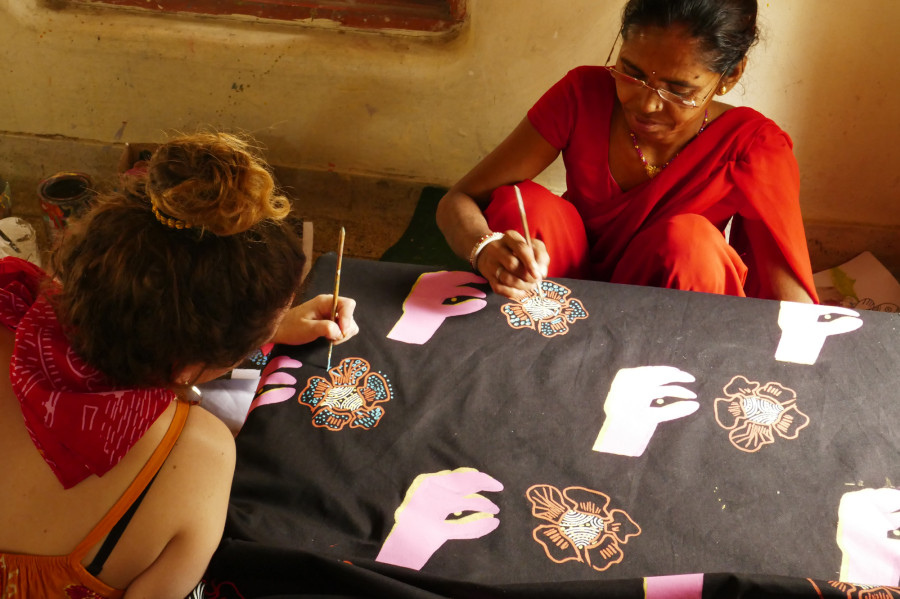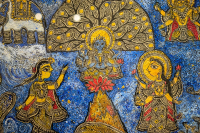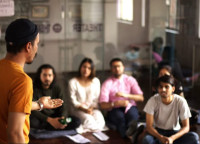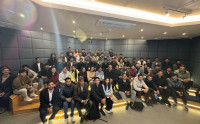Culture & Lifestyle
Handmade in Janakpur
Madhumala Mandal’s house in Kuwa, Janakpur is one of the few remaining ones still covered in Mithila art murals.
Abani Malla
Madhumala Mandal’s house in Kuwa, Janakpur is one of the few remaining ones still covered in Mithila art murals. Modern cement houses in the city no longer act as canvases for this centuries-old culture of painting distinct murals on the walls of homes.
The Mithila art decorating Mandal’s home is uniquely suited to decorating walls, as the style is two-dimensional, colourful and very local. The scenes show women wearing saris and conducting household activities. There are no perspective rules in Mithila art—two-dimensional figures of plants and trees lie on the same plane as humans. Passed down over the centuries from the ancient Mithila kingdom that ruled over northeastern Bihar and parts of the eastern Tarai from 900-500 BCE, Mithila has since spread to parts of Uttar Pradesh and Provinces 1, 2 and 3 in Nepal.
“I’m proud to inherit this culture,” says 40-year-old Mandal, an expert Mithila artist at the Janakpur Women’s Development Centre. “I love to decorate my house with colourful illustrations inspired by my daily life and even from religious sagas like the Ramayana.”
Mithila artwork is largely based on religious symbology but also the daily lives of people, primarily women, objects and animals. Earlier, the medium consisted of simple household objects—even the paint was made of organic material. It was only in the 70s that Mithila art began to be transferred onto paper.
When 25-year-old London-based print designer Ellen Rock first encountered Mithila art, she was struck by how “native, literal and humorous” its depictions of the surroundings and life were. So when Rock, who also goes by Nelly Rose, received a grant from the Arts Council England in 2018, she chose to collaborate with the Janakpur Women’s Development Centre (JWDC) .

For four months, Rock and the women from the JWDC worked together, illustrating fabrics with their own individual art styles, which they later turned into samples of clothing and handbags. The result of this collaboration is currently on display at the British Council in Lainchaur, under the title ‘Her Hands’.
On Rock’s first visit to Janakpur in February 2018, she spent most of her time observing the city and its artistic customs, all while trying to socialise with the 40 Mithila artists from the JWDC. Although Rock had a translator, it took her six weeks to build a good relationship with the women.
Selo Yadav is a perfectionist, says Rock. When Rock asked Yadav to draw a pair of flip flops, she’d expected Yadav to make a stylised drawing in the style of Mithila Art. Instead, she spent an hour making the chappals look as realistic as possible.
“I heard the translator say that Nelly loved how I drew the chappals,” says 45-year-old Yadav who has been working with the JWDC for 20 years. “I felt so happy and appreciated. I wanted to make it as best as I could.”
Regardless of the “massive language barrier” between them, Yadav and Rock managed to connect through their art. The exhibition’s ‘Hand-picked’ series showcases hands illustrated by Rock and flowers painted and detailed by Yadav.
“She detailed the flower in a pop-art style. It looked feminine and strong to me,” says Rock. “Selo respected me too, because I came in as an artist with my own ideas and established a creative relationship with each other.”
Rock also screenprinted her illustrations on fabric, on top of which the Mithila artists would paint in their own art styles, based on certain themes.
“We experimented with our art on fabric and the samples looked so beautiful,” says Rock. “So, I wanted to make a piece of art invested with our collaboration.”
For the exhibition, two large pieces of cloth, one black and one white, were screen-printed with Rock’s illustrations and later, filled with details by the Mithila artists in response to themes such as womanhood—focusing on footsteps, vision, motherhood and friendship.
The exhibition thus narrates a story about how the hands of women make everything possible, says
Mandal, who has been working at the JWDC for 30 years.
Apart from the art itself, Rock felt a strong sisterhood to the artists. They would report to the office at 10 am everyday and would leave for home at 5 in the evening.
“I was touched by their friendship, seeing them holding hands while going home,” says Rock.
At the JWDC, many international artists come to collaborate and the women have many experiences of working with diverse art styles. Although they bring their unique aesthetics and share their conceptual visuals with the women of the community, for the collaborators, including the women, working together is all about sharing a mutual love for art and growing together.
“I’m a fool,” says Yadav. “I know only art and I love it. I’m happy because of it and I don’t feel like doing anything else.”
But Rock thinks that these women sell themselves short. “They say they’re uneducated but they educate others with their powerful art and storytelling,” she says.
For women like Mandal, collaborations can be “empowering” and she plans to pass down all she has learned to her daughter and daughters-in-law.
“After I die, I will be gone,” says Mandal. “But if I teach them, they will realise the power they have in their own hands and can make something out of it.”
‘Her hands’ is showing at the British Council, Lainchaur, every day, from 10 am to 5 pm, until May 15.




 7.15°C Kathmandu
7.15°C Kathmandu













%20(1).jpg&w=300&height=200)

